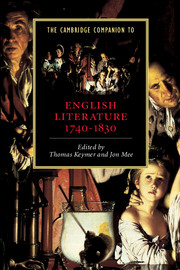Book contents
- Frontmatter
- Part I Contexts and modes
- Part II Writers, circles, traditions
- 8 Richardson, Henry Fielding, and Sarah Fielding
- 9 Johnson, Boswell, and their circle
- 10 Sterne and Romantic autobiography
- 11 Blake and the poetics of enthusiasm
- 12 ‘Unsex’d females’
- 13 The Lake School
- 14 Jane Austen and the invention of the serious modern novel
- 15 Keats, Shelley, Byron, and the Hunt circle
- 16 John Clare and the traditions of labouring-class verse
- Index
- Series list
12 - ‘Unsex’d females’
from Part II - Writers, circles, traditions
Published online by Cambridge University Press: 28 May 2006
- Frontmatter
- Part I Contexts and modes
- Part II Writers, circles, traditions
- 8 Richardson, Henry Fielding, and Sarah Fielding
- 9 Johnson, Boswell, and their circle
- 10 Sterne and Romantic autobiography
- 11 Blake and the poetics of enthusiasm
- 12 ‘Unsex’d females’
- 13 The Lake School
- 14 Jane Austen and the invention of the serious modern novel
- 15 Keats, Shelley, Byron, and the Hunt circle
- 16 John Clare and the traditions of labouring-class verse
- Index
- Series list
Summary
In the 1815 collection Poetic Trifles, a poem entitled 'What came of firing a Gun' describes the unfortunate victim of a boy's killing spree, a bird knocked out of the sky in the poem's first lines:
Ah! there it falls, and now 'tis dead; The shot went through its pretty head, And broke its shining wing! How dull and dim its closing eyes! How cold, and stiff, and still it lies! Poor harmless little thing!
Without knowing anything about the author, we might be tempted to attribute this poem to a woman writer on the basis of its similarity to other sympathetic animal poems such as Anna Barbauld's 'The Mouse's Petition', Mary Robinson's 'The Linnet's Petition', and Charlotte Smith's elegy on the death of a pet dormouse. Male writers, of course, also wrote sentimental animal poems – William Cowper’s ‘On a Goldfinch Starved to Death in His Cage’ is one example – but recent feminist criticism has encouraged us to view women writers’ animal petition poems as a distinct genre, and to read these poems as veiled critiques of masculine power structures. Marlon Ross and Mitzi Myers, for example, both read Barbauld’s poem as a political intervention, with the poem’s trapped mouse standing in for disempowered peoples. ‘What came of firing a Gun’ concludes:
Poor little bird! – if people knew
The sorrows little birds go through,
I think that even boys
Would never call it sport and fun,
To stand and fire a frightful gun,
For nothing but the noise.
- Type
- Chapter
- Information
- The Cambridge Companion to English Literature, 1740–1830 , pp. 211 - 226Publisher: Cambridge University PressPrint publication year: 2004
- 4
- Cited by



